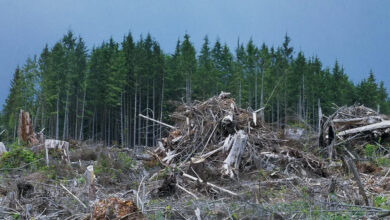Deforestation in the Amazon: Why This Ecological Crisis Matters to Us All
Over the past few years, we have witnessed pictures of fires and smokes captured in the Brazilian Amazon Rainforest. To take account of the reasons for the Amazon Rainforest Deforestation, this horror destruction is neglected somehow. But, these fires are not happening due to any naturally occurring phenomenon, despite its being deliberately done.
The Amazon rainforest is vital to our planet’s health. If we continue to destroy it, we risk losing not just an incredible ecosystem but also the fight against climate change.
The land of the Amazonian Rainforest is illegally being damaged for other uses. This destruction of nature and trees is known as Deforestation. The indigenous communities and wildlife are being affected by this deforestation by making the forest into torn parts. The inhabitants of the Amazon Rainforest are losing their ancestral homes each year to deforestation. The tree depletion rate in this region is very high that we will be discussing below.
Table of Contents
Amazonia Serves to Be a Vital Tool in Climatic Action
According to current statistics for 2021, Amazon Rainforest causing climatic changes in the atmosphere by emitting more carbon dioxide than it is absorbing. It is holding around 150 tons of carbon content.
The Tropical Rainforest affects the climate in broader terms – all around the globe and is depicted to soon be dry out by the year 2050, because of its tipping point.
History of Forest Degradation in Amazon
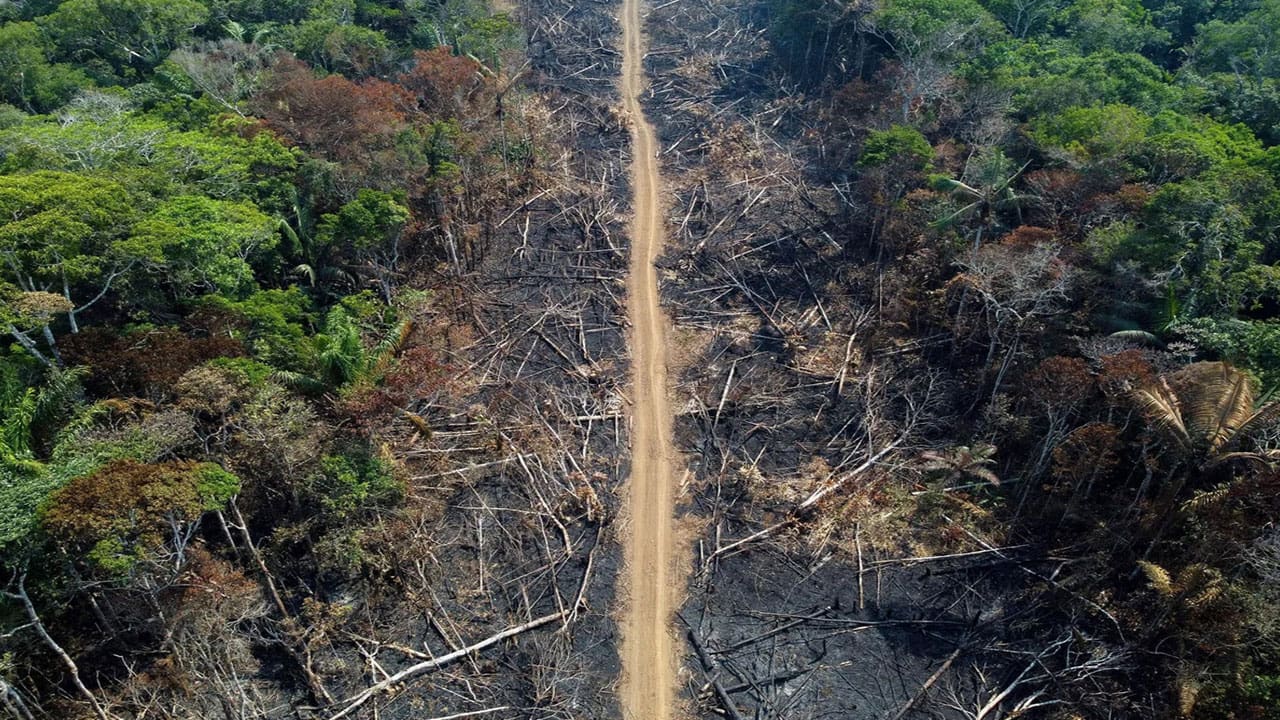
The historical background of deforestation as per the researches, suggests that depletion of the Rainforest started back in the 1960s at the launch of initiatives by the Brazilian government. It was done to promote economic growth by clearing out forest land for uses like farming and cattle ranching.
In the 1970s, it became easier for settlers to access the forest due to the Trans-Amazonian Highway. It has led to massive destruction of the jungle. The global demand for beef and soybeans increased the rate of deforestation even more in the 1990s and 2000s, worsening the link between deforestation and climate change.
Furthermore, Brazil was considered as a top exporter for exporting soybeans and beef. However, some regulations were made to reduce the forest degradation temporarily up till 2010.
Soon after the presidential era of Jair Bolsonaro (2019-2022), the policies started to get weakened and the depletion started taking place. As of today’s date, The Brazilian Basin is facing environmental crises due to illegal mining and logging.
11 Ultimate Facts of Amazon Basin Destruction
Let’s proceed with some facts highlighting about this land clearance bellow;
Over 40% of Global Tropical Deforestation Occurs in Brazil
On a global level, there is about 5 million hectares of forest which is lost due land clearing. The forest clearing happens due to a number of reasons. It may include livestock farming, agriculture, logging to make materials such as palm oil, paper, gold mining and soy production too. The Amazon rainforest plants and trees possesses numerous medicinal and herbal qualities for mankind.
Nine countries come under the Amazonia, but 60% of its area comes within the Brazilian region. Around 1.5 million hectares of jungle is depleted yearly in Brazil regardless of the efforts made to control this forest loss.
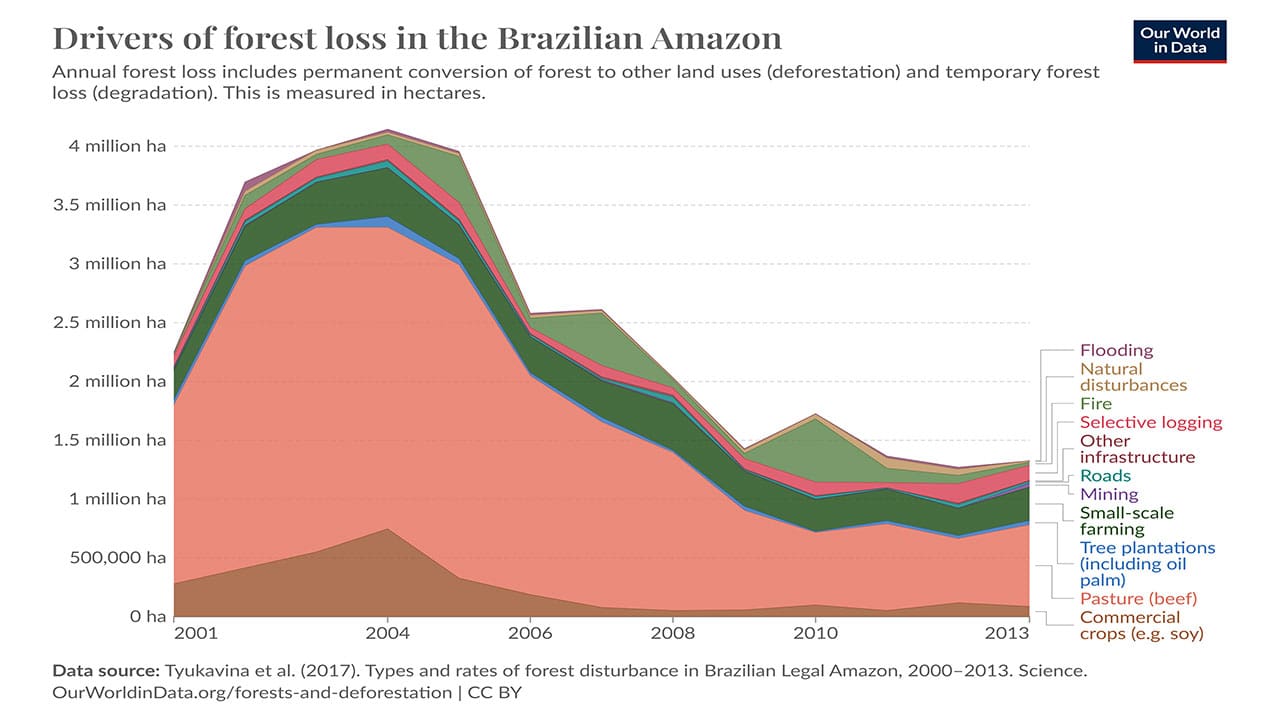
Beef Production is the Biggest Driver for Deforestation in the Amazon
Beef has increased its demand increasingly in the region of US and China, as top beef consumers in the world. The consumption of meat in these two countries have increased around one third globally. It is expected that by the year 2028, developing countries may consume meat four times more.
Every year, the Amazonian jungle faces losses of about 81,081 square meters due to beef production with a percentage of 80%. The forest has lost its land of more than 3,800 square meters since August 2018 up till July 2019, which is done to create pasture for the farming of cattle.
Gold Mining in the Amazon is on the Rise
The worrisome factor is gold mining occurring in the Amazonian Jungle, which has increased over recent years. It is specifically found in the Guiana Shield, as the gold market is growing rapidly at global level.
The gold mining projects significantly cause environmental degradation of the jungle, which causes soil erosion and water contamination. This limits the regrowth of the forest trees and makes them produce less-carbon accumulation.
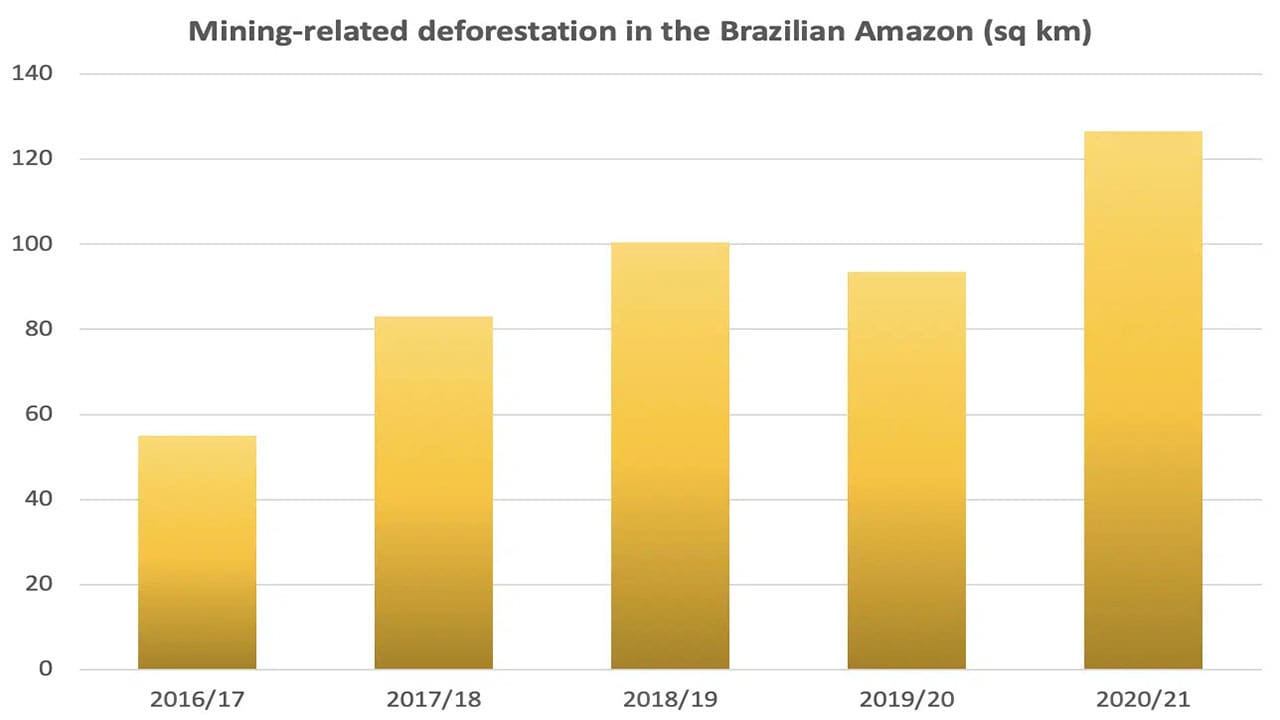
Soybean production is a growing threat:
Brazil is responsible for producing one third of soybeans globally. The production of soybean plays a massive role in deforestation, which has a percentage of 12%.
The Blue Macaw is One of the Many Species under Threat
The Blue Macaw is found in the forest of Brazilian Rainforest which is also known as The Hyacinth Macaw. The species of these blue macaws are considered in the list of the endangered due to its illegal logging. Some people might think as if the blue macaw are really extinct?. At the current date, it is only found in small regions like Pará- epicenter of deforestation.
Related Pick: Discover the Wild Wonders of Amazon Rainforest Animals
Deforestation has Turned the Amazon Rainforest into a Carbon Source
Deforestation in the Amazonia has increasingly become a source of carbon. Although, the Amazon rainforest has a vital importance in absorbing and storing the carbon dioxide, which helps deforestation by reducing the carbon content from the atmosphere.
Unfortunately due to deforestation, this process is declining. A billion tons of carbon dioxide is being released yearly in the jungle of Amazon.
Deforestation Rates were High under Bolsonaro’s Presidency
The rate of forest depletion has risen to higher levels in the presidential era of Jair Bolsonaro(January 2019). Jair has been in support of logging and mining by illegal practices that has promoted deforestation in his government.
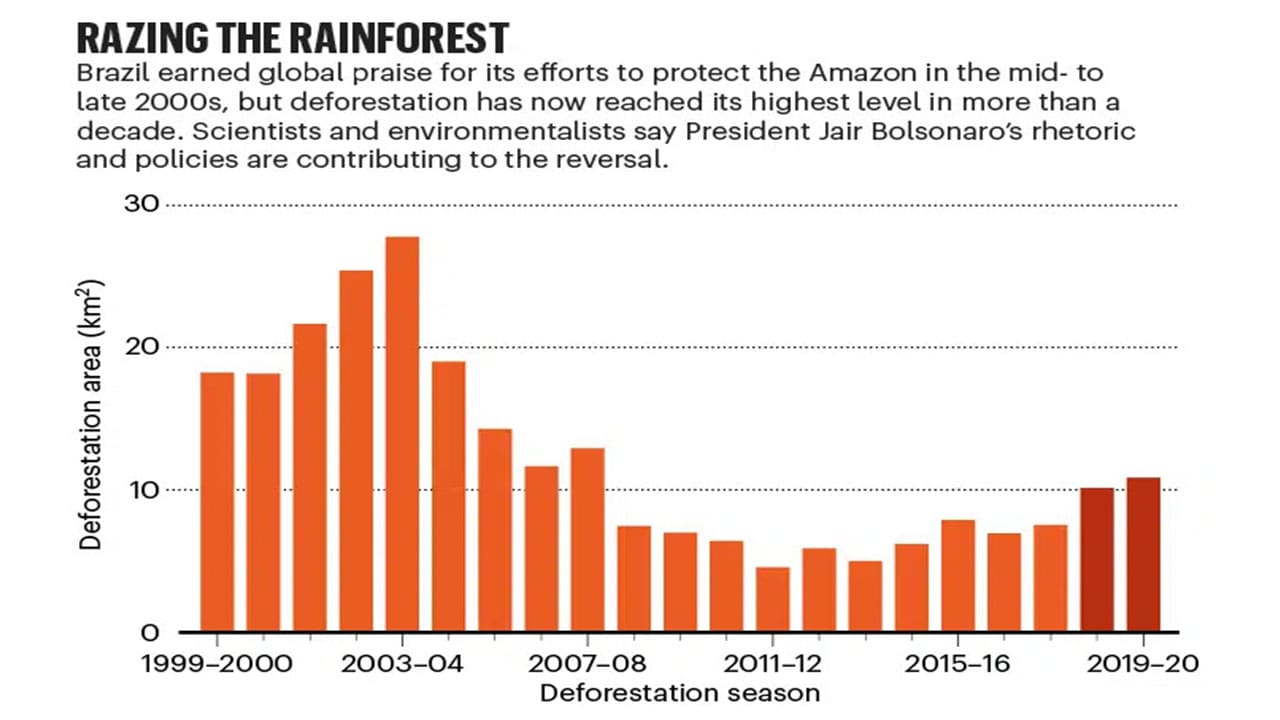
This resulted in several complaints which were filed against him at the International Criminal Court.
Amazon Rainforest is at Risk of Collapse
A study (February 2024) found that between 10% and 47% of Amazonian forests are at risk of collapsing by 2050. The study analyzed the main causes of the water stress which included droughts, high temperature, fires, deforestation, also in the remote areas of the jungle.
Indigenous Communities are Key to Protecting the Rainforest
The indigenous communities are considered to safeguard and preserve the jungle by acting as a barrier against logging and forest degradation. These communities have deep roots and connections with the forest land.
A research found out that communities living in the region of Peru uses smartphones and satellite data. It helps them in reducing the logging activities happening in the Amazon jungle.
The EU is Banning Food Imports from Deforested Areas
The European Union has taken an initiative to ban six food and agricultural products that are imported from the deforestation in Amazon Rainforest. The initiative was taken to protect the environment of Tropical Rainforest from illegal forest degradation.
More than 100 Countries Pledged to End Deforestation
There were more than 100 countries at the COP26 climate summit, who promised to stop the forest depletion by 2030, Brazil was also included in these countries. That was surprising for many to see the involvement of Brazil.
You Might Like to Read: Impact of Forest Loss on Biodiversity Loss
However, Bolsonaro has a bad record previously on environmental issues. Therefore, some recent advancements are made to improve and protect the forests from illegal logging and cutting down.
Causes of Amazonian Tree Depletion
Cattle ranching
The leading cause of tree cutting in the Amazon Tropical Forest is cattle ranching. It is around 80% of the depletion, which releases 340 million tons of carbon in a year. A rise of 8% is seen in cattle in the year 2020.
Logging
The second other cause includes illegal logging of woods and trees in the jungle. The rise in logging has increased its number with the passage of time. The logging is happening due to commercial uses like paper making, for making furniture and so and so forth.
Mining
The mining can be another major cause of forest loss, which may give rise to soil pollution and water pollution due to illegal mining. It also causes mercury contamination happening in the forest due to mining activities. Gold mining with 90% is seen in the area of Guiana Shield in Amazonia, which is the reason for forest destruction.
Climate Change
The changing climate has also become a reason for forest clearing. Due to this, the jungle has become dried with less moisture, which has critically damaged the biodiversity of the jungle. The climate crisis affected the resilience of the Amazon Basin by producing more content of carbon in the atmosphere, hence discovered in a study held in 2021.
Agriculture
The agricultural practices are the major cause of forest loss. The excessive use of pesticides and chemical fertilizers causes damage to the nature and inhabitants of the region. The demand of crop and meat products has increased, which has depleted the forest, bringing loss of the jungle.
Human Activity
The contributing factor in the destruction of trees and forest might be the increase in population on the land of Amazon. Human activities affect infrastructure development, which includes dams, hydropower projects and roads. All of this puts a pressure on the tropical forest disrupting its ecosystem.
Conclusion
The negative effects of deforestation in the Amazon Basin is impacting not only the environment of the jungle, but also causing severe environmental crises on a global level in terms of climatic changes. These illegal activities are happening for a number of reasons which include soybean farming, cattle ranching, mining, and logging.
It also disrupts the living standards of the indigenous tribal communities of the Brazilian forest, causing harmful climatic changes in the atmosphere. However, the global climate is disturbed due to the destruction of the Amazonia.
Read More: Birds of the Amazon Rainforest
